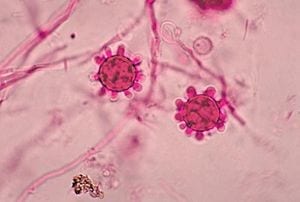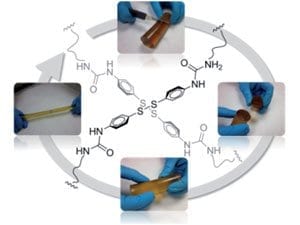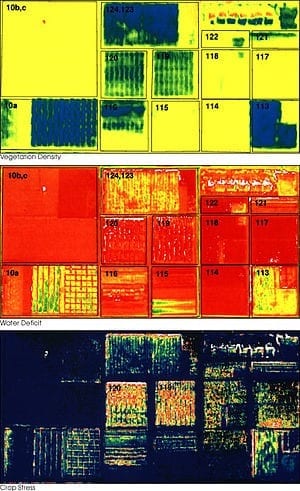
Fluorescent fungal cells help researchers quickly identify most effective compounds
On a molecular level, you have more in common with shower curtain mold or the mushrooms on your pizza than you might think. Humans and fungi share similar proteins, a biological bond that makes curing fungal infections difficult and expensive. Current costs to treat these stubborn infections can top $50,000 per patient, and no new classes of antifungal drugs that treat systemic infections have been introduced for at least 20 years.
Now, researchers at The Ohio State University Wexner Medical Center have discovered a new compound that could be developed as an antifungal drug to treat histoplasmosis and cryptococcosis, two types of fungal infections that are naturally drug-resistant.
Generally, people with weakened immune systems are more likely to develop life-threatening fungal infections. However, the airborne fungus Histoplasma capsulatum, which causes histoplasmosis, can infect healthy people as well.
“Histoplasmosis is an unusual fungal disease because anyone can be infected, not just people with compromised immune systems. Like tuberculosis, Histoplasma infects healthy hosts, attacks their lungs, and can lie dormant in immune cells for years, later causing reactivation disease,” said Chad Rappleye, PhD, a microbiologist in the Center for Microbial Interface Biology at Ohio State’s Wexner Medical Center and in the Department of Microbial Infection and Immunity at Ohio State’s College of Medicine. “So this is an unrecognized public health threat that’s needed better treatment options for some time.”
There are an estimated 100,000 Histoplasma infections each year in the United States. Most are contained by the body’s immune system, but each year a few thousand people will develop chronic or life-threatening histoplasmosis disease requiring hospitalization and antifungal treatment. The antifungals currently used to treat the infection have undesirable toxic side effects requiring monitoring by a physician and may need to be taken for weeks or months.
“Histoplasma is particularly good at avoiding detection by the body’s immune system and surviving the immune response,” said Jessica Edwards, PhD, a postdoctoral researcher at Ohio State University.
Respiratory histoplasmosis manifests with flu-like symptoms, often making diagnosis difficult. Rappleye says people with histoplasmosis have been mistakenly diagnosed with colds, the flu, and even lung cancer. “It depends on how familiar a physician is with histoplasmosis,” he said.
Intrigued by the challenges of finding a new drug that would target the fungus without harming the human host, in 2012, Rappleye received pilot funding from Ohio State’s Center for Clinical and Translational Science (CCTS) and the Public Health Preparedness for Infectious Diseases Program (PHPID).
Rappleye’s team searched a library of commercially-available small molecules used by other investigators to find new antivirals or anticancer drugs. They performed a high-throughput phenotypic screen of 3,600 compounds looking for agents that inhibited fungal, but not human, cells.
To speed the selection process, Rappleye and Edwards engineered Histoplasma cells with a fluorescent protein that made the cells glow red while inside of a living macrophage – the type of mammalian immune cell that Histoplasma attacks and in which it reproduces.
As the number of fungal cells increased inside the macrophage, so did the fluorescence and consequently, the cells would glow brighter. However, when a macrophage was exposed to an active compound that prevents Histoplasma reproduction, it maintained the same level of brightness. This allowed the scientists to quickly determine efficacy and toxicity of the drug candidate in a natural environment.
“Not only were we able to visually screen thousands of compounds in just a few weeks, but we were also able to measure the compound’s impact in a real, live host cell,” said Edwards.
Go deeper with Bing News on:
Fungal Lung Infections
- Oral fungal infection treatment shows promise in preclinical trials
A novel oral amphotericin B (MAT2203) developed by Matinas BioPharma for treatment of invasive mucormycosis (IM) and other deadly invasive fungal infections, has demonstrated encouraging results in a ...
- In Vivo Efficacy of Matinas BioPharma’s Oral MAT2203 in Pulmonary Mucormycosis Published in Journal of Antimicrobial Agents and Chemotherapy
Studies in neutropenic mouse model demonstrate prolonged and enhanced survival, reduced fungal burden and improvement in lung infectionBEDMINSTER, N.J., April 30, 2024 (GLOBE NEWSWIRE) -- (NYSE ...
- From blue to black, purple to green – what the COLOUR of your tongue means and when to seek help
WE use them to talk, taste, chew and swallow – but experts say tongues also hold vital information about our overall health. This is particularly true when it comes to colour, according to a ...
- CDC ‘disease detectives’ study mold infections in COVID patients, more
The EIS officers — better known as CDC’s disease detectives — will give 104 presentations and one of them looks no further than the conference itself last year for a case study in a quickly spreading ...
- Five diseases you can catch from pet birds
Catching diseases from a pet bird is possible through exposure to pathogens present in the bird’s feces, saliva, or feathers.
Go deeper with Google Headlines on:
Fungal Lung Infections
[google_news title=”” keyword=”Fungal Lung Infections” num_posts=”5″ blurb_length=”0″ show_thumb=”left”]
Go deeper with Bing News on:
Fungal infections
- A bizarre fungus is threatening two emerging cicada broods
NPR's Juana Summers talks with mycologist Matt Kasson about a strange fungus that is threatening certain broods of periodical cicadas.
- Here’s How Zinc Can Help You Combat Vaginal Yeast Infections
Zincs antifungal immune-supporting and anti-inflammatory properties make it a valuable ally in managing and preventing vaginal yeast infections ...
- Oral fungal infection treatment shows promise in preclinical trials
A novel oral amphotericin B (MAT2203) developed by Matinas BioPharma for treatment of invasive mucormycosis (IM) and other deadly invasive fungal infections, has demonstrated encouraging results in a ...
- Ringworm in the house: How indoor pets catch this fungal foe
Ringworm infections in pets can lead to hair loss, skin lesions, and potential transmission to other animals and humans.
- Doubled estimate of fatal fungal infections sharpens scientific focus
“A more likely explanation for Candida auris emerging is that it is a drug-resistant biofilm,” says Fisher. “The very high use of antifungal chemicals in patients and in the environment has opened up ...
Go deeper with Google Headlines on:
Fungal infections
[google_news title=”” keyword=”fungal infections” num_posts=”5″ blurb_length=”0″ show_thumb=”left”]










